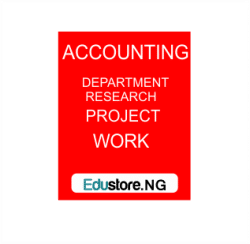Leverage and its influence on profitability has been a major point of argument among researchers, since different research comes up with divergent views to explain how relevant or irrelevant it is. This study examines the impact of leverage on profitability of Listed Healthcare firms in Nigeria for a period of 10 years (2004-2013). The study employs return on asset (ROA), return on equity (ROE) and earnings per share (EPS) as proxies for profitability and Total debt to total asset, Long-term debt to total asset and Short-term debt to total asset as measures for leverage, and using secondary data extracted from the firm’s financial statements and the Nigerian Stock Exchange fact book. Seven firms formed the sample size out of the ten listed healthcare firms in the Nigeria stock exchange market. The study employs a correlational design and use robust ordinary least square regression technique to analyse the data, while using the variance inflation factor as a check on harmful Collinearity among variables. The result shows that total debt to total asset (TDTA) has a significant positive impact on ROE and a significant negative impact on EPS. The result also shows that long-term debt to total asset (LTDTA) has a significant positive impact on ROE. Finally, the result shows that short-term debt to total asset (STDTA) has a significant negative impact on ROA and EPS. Hence, the study recommends that if management wants to increase return on equity, the study suggest that management should increase the total debt value but if the focus is to increase earnings per share, the study recommends that total debt be reduced. Management should increase the level of long-term debt to increase firms return on equity ratio. Finally, management should consider reducing the level of short-term debt in their debt structure in order to increase return on asset and earnings per share of their firm.
In a bid to understanding how leverage affects firms, there is need to understand profitability and its influence on leverage choices. Profitability, which is usually regarded as the lifeblood of a business venture, is another key ingredient that affects manager’s decisions on the use of leverage in firms capital structure (Ali & Iman, 2011). For newly established business enterprise, the use of leverage as a finance option may be for stability and expansion but for old existing firms the need for leverage might be different. Policies on the use of leverage are expected to change in the event where profit is involved. Profitability as a key aspect of business survival may have different types of impact on the firm’s capital structure and this effect may range from positive to negative territories (Adeyemi & Oboh, 2011; Ali & Iman, 2011; Akintoye, 2008; Titan & Zetium, 2007). Having said the above, the relevance of leverage to firm’s value was questioned in the famous work of Modigliani and Miller of 1958, where they argued that capital structure has no relevance on the value of the firm under the perfect market condition settings. However, many researchers questioned this proposition, among which, is the work of Jensen and Meckling (1976), they postulated that the amount of leverage in a firm’s capital structure affects the managers’ choice of operating activities and that it has a bearing on the overall firm performance and its’ total value. Many other researchers argued that capital structure has an effect on the overall value of firms only that this effect ranges from positive to negative (Ali & Iman, 2011; Oke & Afolabi, 2008 and Abor, 2005). Pragmatically, the conclusion reached by previous research, which ranges from positive to negative shows the uniqueness of each country’s economy in terms of its market
DOWNLOAD COMPLETE WORK- For Reference Only: Materials are for research, citation, and idea generation purposes and not for submission as your original final year project work.
- Avoid Plagiarism: Do not copy or submit this content as your own project. Doing so may result in academic consequences.
- Use as a Framework: This complete project research material should guide the development of your own final year project work.
- Academic Access: This platform is designed to reduce the stress of visiting school libraries by providing easy access to research materials.
- Institutional Support: Tertiary institutions encourage the review of previous academic works such as journals and theses.
- Open Education: The site is maintained through paid subscriptions to continue offering open access educational resources.






